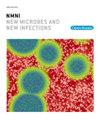Clavispora sputum sp.nov.的生物学和基因组分析,它是一种潜在的新型真菌病原体,与Clavispora lusitaniae(Candida lusitaniae syn.
IF 2.9
Q2 INFECTIOUS DISEASES
引用次数: 0
摘要
在过去二十年中,出现了多种人类真菌病原体,包括耐药白色念珠菌和haemulonii白色念珠菌复合菌种,对人类健康构成了新的威胁。在这项研究中,我们报告了从一名 COVID-19 患者的临床痰液样本中分离和鉴定出的属于 Clavispora 属的一个新物种,在此命名为 Clavispora sputum。Cl. sputum 在系统发育上与真菌病原体 Clavispora lusitaniae(同属 Candida lusitaniae)和 C. auris 关系密切。当在 CHROMagar Candida Plus 培养基上生长时,Cl.痰表现出与 C. auris 菌株 CBS12372 相似的颜色。痰菌在 CM 培养基上能长出细弱的菌丝。虽然痰菌和卢西塔尼亚痰菌在系统发育上关系密切,但比较基因组和同源染色体分析表明这两个物种之间存在明显的染色体重排。虽然痰酵母菌不能在 37 °C的常规培养条件下生长,但小鼠全身感染模型肺组织中真菌负担的增加意味着痰酵母菌可能是人类的一种潜在机会致病酵母菌。本文章由计算机程序翻译,如有差异,请以英文原文为准。
Biological and genomic analyses of Clavispora sputum sp. nov., a novel potential fungal pathogen closely related to Clavispora lusitaniae (syn. Candida lusitaniae) and Candida auris
Several human fungal pathogens, including drug-resistant Candida auris and species of the Candida haemulonii complex, have emerged over the past two decades, posing new threats to human health. In this study, we report the isolation and identification of a novel species belonging to the genus Clavispora, herein named as Clavispora sputum, from a clinical sputum sample of a COVID-19 patient. Cl. sputum is phylogenetically closely related to fungal pathogens Clavispora lusitaniae (syn. Candida lusitaniae) and C. auris. When grown on CHROMagar Candida Plus medium, Cl. sputum exhibited a similar coloration to C. auris strain CBS12372. Cl. sputum was able to develop weak filaments on CM medium. Although Cl. sputum and Cl. lusitaniae are phylogenetically closely related, comparative genomic and synteny analyses indicated significant chromosomal rearrangements between the two species. Although Cl. sputum could not grow at 37 °C under regular culture condition, an increased fungal burden in the lung tissue of a mouse systemic infection model implies that it could be a potential opportunistic pathogenic yeast in humans.
求助全文
通过发布文献求助,成功后即可免费获取论文全文。
去求助
来源期刊

New Microbes and New Infections
Medicine-Infectious Diseases
CiteScore
10.00
自引率
2.50%
发文量
91
审稿时长
114 days
 求助内容:
求助内容: 应助结果提醒方式:
应助结果提醒方式:


